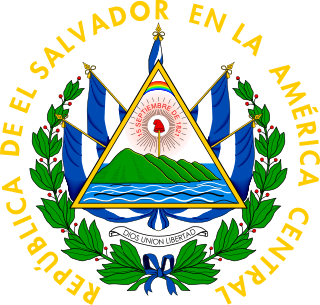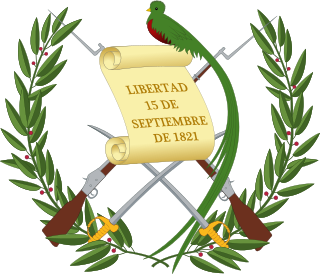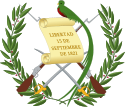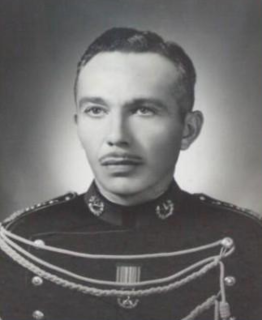The Grow Party formerly Grand National Alliance was a right-wing conservative political party in Guatemala. The acronym "GANA" also spells out the word gana, from the verb ganar, "to win".

General elections were held in Guatemala on 7 March 1982. Ángel Aníbal Guevara, hand-picked successor of previous president Romeo Lucas García, was declared the winner of the presidential election and was scheduled to take office on 1 July. However, the election was widely denounced as fraudulent by elements on both sides of the political spectrum and an army-led coup d'état on 23 March instead installed the three-man junta of General Efraín Ríos Montt, General Horacio Maldonado Schaad, and Colonel Francisco Luis Gordillo Martínez.

Legislative elections were held in El Salvador on 10 March 1974. The result was a victory for the National Conciliation Party, which won 36 of the 52 seats whilst the National Opposing Union won only 15. However, the election was marred by massive fraud and the official vote counts were not published.

General elections were held in Guatemala on 6 March 1966. After no candidate received 50% or more of the national vote, Julio César Méndez Montenegro was elected President by Congress on 10 May. On the Congressional elections, the Revolutionary Party won 28 of the 54 seats. Voter turnout was 56.27% in the presidential election and 55.01% in the Congressional elections

General elections were held in Guatemala on 1 March 1970. No candidate received over 50% of the vote in the presidential election, resulting in Carlos Manuel Arana Osorio being elected by Congress on 21 March. The National Liberation Movement-Institutional Democratic Party alliance won the Congressional elections. Voter turnout was 53.82% in the presidential election and 53.26% in the Congressional elections.

General elections were held in Guatemala on 5 March 1978. No candidate received more than 50% of the vote in the presidential election, resulting in Fernando Romeo Lucas García being elected president by Congress on 13 March. The Congressional elections were won by the National Liberation Movement.

General elections were held in Guatemala on 12 November 1995, with a second round of the presidential elections held on 7 January 1996. Álvaro Arzú of the National Advancement Party won the presidential election, whilst his party also won the Congressional elections. Voter turnout was 46.8% on 12 November and 36.9% on 7 January.

General elections were held in Guatemala on 19 January 1958 after the 1957 elections were nullified. After no candidate received 50% or more of the national vote, Miguel Ydígoras Fuentes was elected President by Congress on 12 February, whilst an alliance of the National Democratic Reconciliation Party, Nationalist Democratic Party, the Nationalist Liberal Party, the Democratic National Association and the National Anti-Communist Front won 40 of the 66 seats in Congress.

Parliamentary elections were held in Guatemala on 3 December 1961, in order to elect half the seats in Congress. Following the election, the National Democratic Reconciliation Party-National Democratic Movement-Democratic Unity Party alliance held 50 of the 66 seats. Voter turnout was just 44.48%.

Constitutional Assembly elections were held on 24 May 1964. The Movement of National Liberation and the Revolutionary Party both won 10 seats, although sixty members were appointed by the military government.

Parliamentary elections were held in Guatemala between 26 and 28 November 1948 in order to elect half the seats in Congress. The National Renovation Party-Revolutionary Action Party alliance won the most seats, but the Popular Liberation Front remained the largest party.
Legislative elections were held in Guatemala to elect members of the Congress on 3–5 November 1944.
A presidential election was held in Guatemala on 17–19 December 1944. The October Revolution of 1944 had overthrown Jorge Ubico, the U.S. backed dictator of Guatemala. A junta composed of Francisco Javier Arana, Jacobo Árbenz and Jorge Toriello took power, and quickly announced presidential elections, as well as elections for a constituent assembly. The subsequent elections took place in December 1944, and were broadly considered free and fair, although only literate men were given the vote. Unlike in similar historical situations, none of the junta members stood for election. The front-runner was the philosophically conservative University professor Juan José Arévalo, of the Renovación Nacional. Arévalo's closest challenger was Adrián Recinos, whose campaign included a number of individuals identified with the Ubico regime. The ballots were tallied on 19 December 1944, and Arévalo won in a landslide, receiving more than four times as many ballots as the other candidates combined.

General elections were held in Guatemala between 6 and 8 February 1931. In the presidential election Jorge Ubico was elected unopposed, after the remaining sector of the old Liberal Party did not object to his candidacy, whilst the Conservative Party was too disorganised and discredited from the Lázaro Chacón González era to put forward a candidate. Ubico's Progressive Liberal Party, formed by a union of the two wings of the divided Liberal Party also won the parliamentary election unopposed.

General elections were held in Guatemala on 5 December 1926. The presidential election resulted in a victory for Lázaro Chacón González, who received 88.6% of the vote. Whilst the elections were rigged, the Progressive Liberal Party did manage to win some seats in the Congress.

Constitutional Convention elections were held in Guatemala in June 1927. Lázaro Chacón González put 33 senior officers on the official list of candidates, and whilst civilian leaders of the Liberal Party were also on it, the fact that most of them were members of the armed forces suggested that González was determined to dominate the Convention.
Renewed Democratic Liberty was a centre-right political party in Guatemala.

Presidential elections were held in the Dominican Republic on 20 May 2012. They were the fifth quadrennial elections for the presidency and vice-presidency since 1998, when a change in the electoral law separated the presidential from the congressional and municipal elections.
Ernesto Antonio Claramount Rozeville (1924–2008) was a militant and politician in El Salvador.













